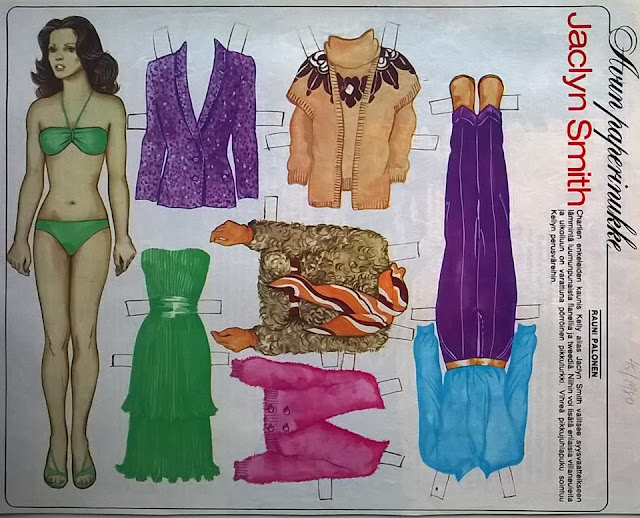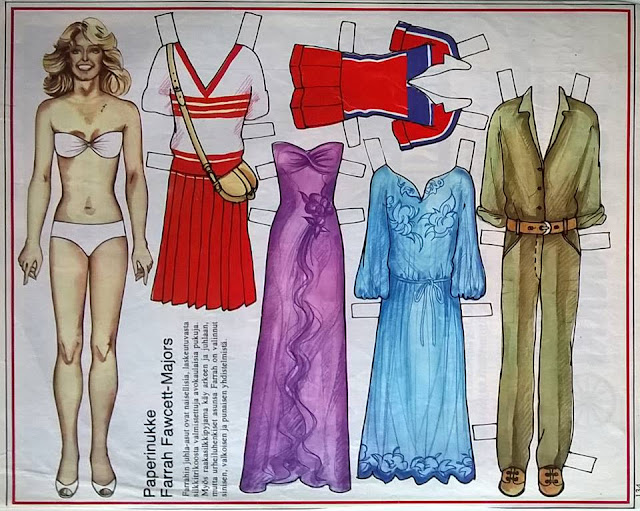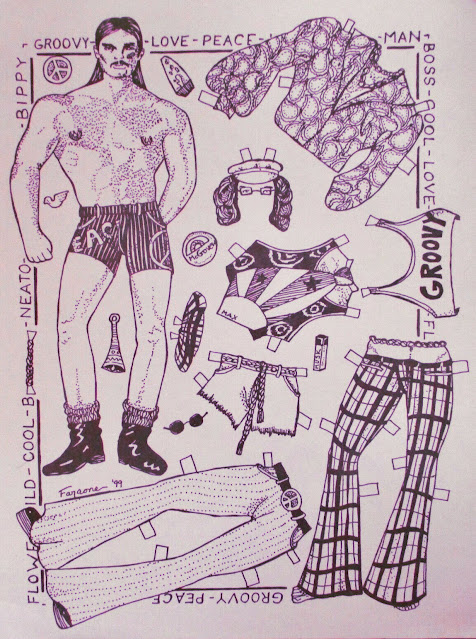 |
| Rauni Palonen by Petri Mulari,2020 |
Rauni Palonen (b.1929- ) is Finnish and designed paper dolls for the magazines Apu and Aret Runt, for thirty years, portraying the royalty, Misses, musicians, actors, actresses, athletes and children's characters.
We had already shared some in previous posts. Take a look here and here.
She graduated in Fashion Design and began designing costumes for theatre and cinema. Then she started working as a fashion journalist during the week and on the weekends she designed celebrity paper dolls at the request of Eero Sauri, editor-in-chief of Apu magazine at the time.
Once a week, Rauni drew a public figure chosen by the editors at the magazine's weekly meeting. The clothes had to follow the trends of the time... this was easy for Rauni as she travelled as a fashion journalist to all the big fashion fairs: Paris, Frankfurt, Milan, Copenhagen.
The magazine aimed to be for the whole family, so they published the paper doll behind an advertising page. This way children could cut out the paper doll without damaging the magazine.
In some published interviews, Rauni shared that she drew thinner bodies because it was difficult to find space on the A4 sheet to place the outfits. The colours of the illustrations usually changed with printing, leaving the paper dolls with crazy colours, but this didn't bother the little ones.
Initially, Rauni's paper dolls varied in pose and were published one week with some clothes, accompanied by a brief description and in the following two weeks more clothes were published on a new two pages.
 |
| Leena Brusiin Miss Europe 1968 by Rauni Palonen |
 |
| Out fits for Leena Brusiin |
 |
| Georg Liemola by Rauni Palonen |
 |
| Outfits for Georg Liemola |
Over time, the space in the magazine for paper dolls decreased and so did paper dolls. They were now published smaller and with less clothing.
It was with the magazine's young readers in mind and so that they could change clothes from one doll to another, that it was decided to create a paper doll base model for men and another for women, changing only the face weekly. Rauni shared that she found it easier to draw men than women.
 |
| Jaclyn Smith (Charlie's Angels) by Raunin Palonen |
 |
| Farrah Fawcett (Charlie's Angels) by Rauni Palonen |
 |
| Cheryl Ladd (Charlie's Angels) by Rauni Palonen |
 | |
| Pippilotta is the main character of three children's books by Swedish author Astrid Lindgren |
The book Tähdet arkilla: suomalaisten suosikit paperinukkeina (Stars on a sheet: Finnish favourites as paper dolls) was published in 2008 and is full of photos and stories about Apu's paper dolls.
 |
|
Tähdet arkilla/ Pirkko Vekkeli, Rauni Palonen,Mia Dillemuth.Tammi, 2008 |
Rauni held an exhibition with her fashion illustrations in 2017.
We should call her the Queen of paper dolls!
See you. 😉
Bibliographic references:
https://www.apu.fi/artikkelit/virve-rosti-16-paasi-rauni-palosen-paperinukeksi-1975-se-oli-suuri-kunnianosoitus
https://nukkehuone.blogspot.com/ maariainen
https://diamonenblogi.blogspot.com/
_____________________________________________________________________________
Rauni Palonen (n.1929-) é finlandesa e desenhou paper dolls para as revistas Apu e Aret Runt, durante trinta anos, retratando a realeza, Misses, músicos, atores, atrizes, atletas e personagens infantis. Formou-se em Design de Moda e começou a desenhar figurinos. Depois começou a trabalhar como jornalista de moda durante a semana e nos finais de semana desenhava bonecos de papel de celebridades a pedido de Eero Sauri, editor-chefe da revista Apu na época. Uma vez por semana, Rauni Palonen desenhava uma figura pública escolhida pelos editores na reunião semanal da revista. As roupas tinham que seguir as tendências da época... isso foi fácil para Rauni, que viajava como jornalista de moda para todas as grandes feiras de moda: Paris, Frankfurt, Milão, Copenhague. A revista pretendia ser para toda a família, por isso publicaram a paper doll atrás de uma página publicitária. Assim as crianças poderiam recortar a paper doll sem danificar a revista. Em algumas entrevistas publicadas, Rauni compartilhou que desenhava corpos mais magros porque era difícil encontrar espaço na folha A4 para colocar as roupas. As cores das ilustrações geralmente mudavam com a impressão, deixando as paper doll com cores malucas, mas isso não incomodava os pequenos. Inicialmente as paper doll de Rauni variavam em pose e eram publicados uma semana com algumas roupas, acompanhadas de uma breve descrição e nas duas semanas seguintes mais roupas eram publicadas em uma nova página. Com o tempo, o espaço na revista para paper doll diminuiu e os bonecos de papel também. Eles agora eram publicados em tamanhos menores e com menos roupas.
Foi a pensar nos jovens leitores da revista e para que pudessem mudar de roupa de um boneco para outro, que se decidiu criar um modelo base da paper dolll para homem e outro para mulher, mudando apenas o rosto semanalmente. Rauni compartilhou que achava mais fácil desenhar homens do que mulheres. Em 2008 foi publicado o livro Tähdet arkilla que está repleto de fotos e histórias sobre as bonecas de papel de Apu. Rauni fez em 2017 uma exposição com suas ilustrações de moda. Deviamos chama-la de rainha das Paper doll! Até à próxima.












.jpg)
-1.jpg)




















